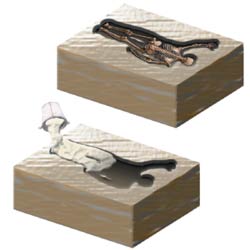|
« previous 17 of 38 next » | |||
All the remaining people in Pompeii—as well as the neighboring city of Herculaneum—were quickly suffocated from the gas and ash that barreled down the mountain, eventually burying them in 10 to 25 feet of volcanic ash and debris. Amazingly, just a few hundred years ago, excavations of Pompeii revealed an amazing thing: the ash had preserved buildings, objects, and paintings on the walls, called “frescoes”. Even the people and some animals were preserved as they were petrified. Basically, the gentle ash that covered everything turned into solid rock. It held everything in the same position just as it was on August 24th, 79 A.D. During the excavations of Pompeii in the 1800’s, a system was invented for making plaster casts of the people who had been covered in ash. The ash had hardened around the bodies of people trying to escape, but over time the bodies decomposed and there were only burned skeletons inside. When the skeletons were removed, the hardened ash kept its shape and could be used like a mold. Plaster was poured into the space where the body had been, and a cast was made in the shape of each person. |
|||
